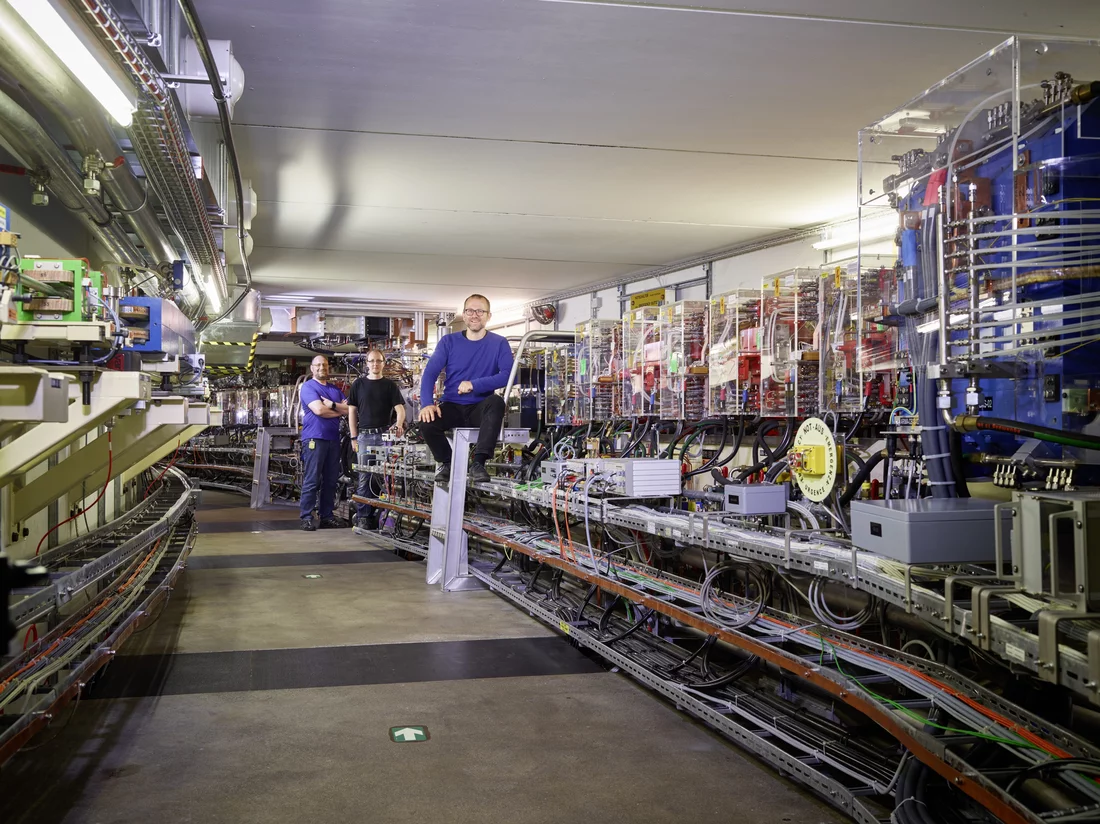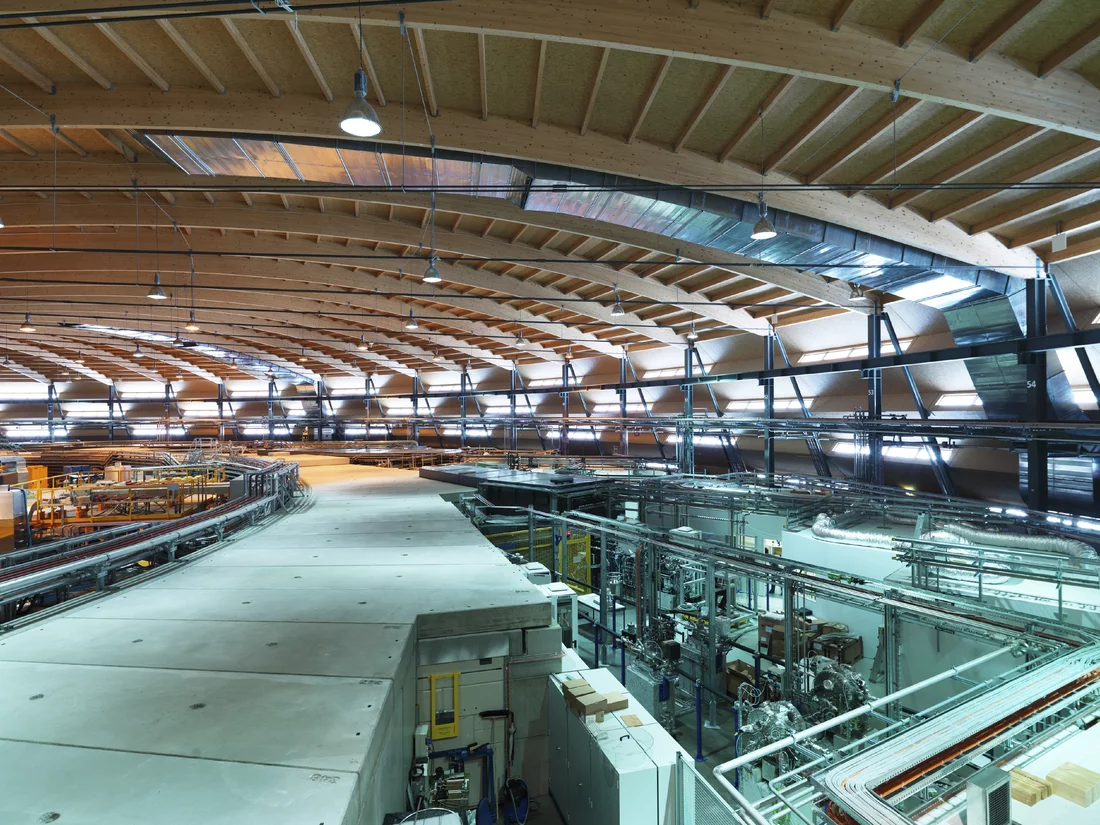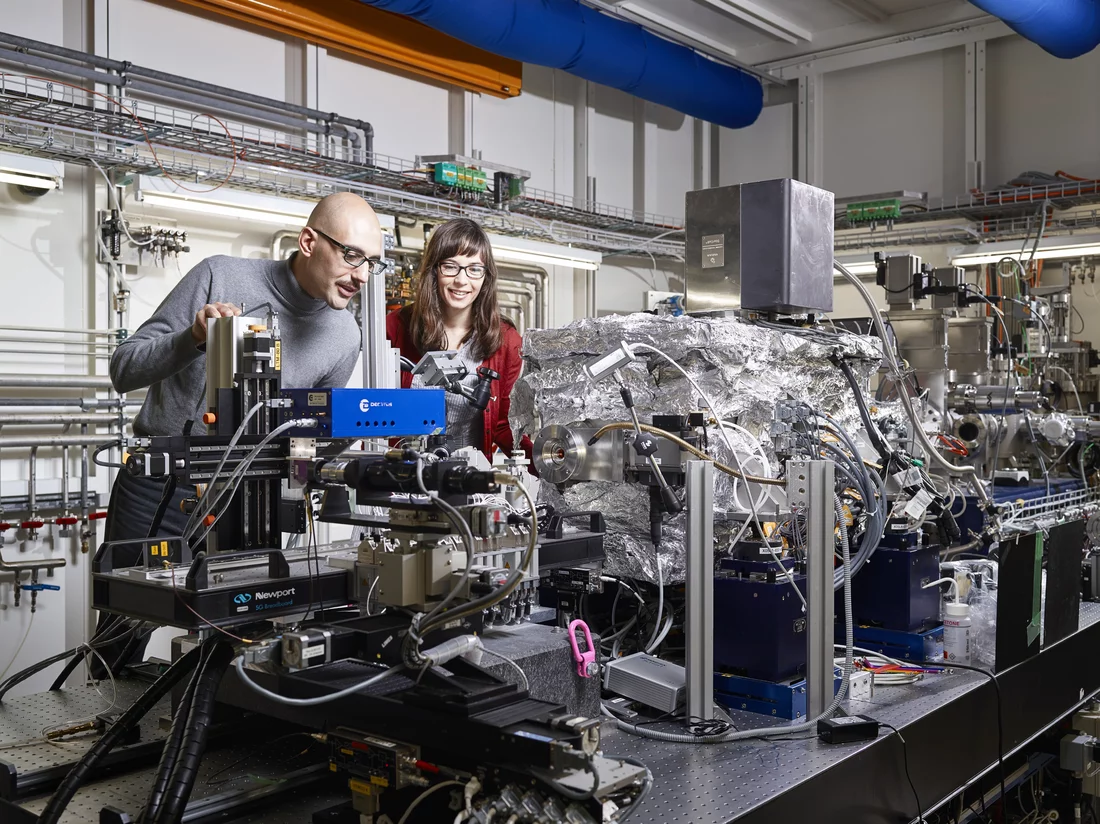The Swiss Light Source SLS is housed in a striking building on the western campus of the Paul Scherrer Institute PSI. Ultra-rapid electrons have been generating top-class X-rays for research here since it opened its doors in 2001. And operations manager Andreas Lüdeke has been on board since the very beginning. He knows the facility like the back of his hand, inside and out.
Anyone who drives through the Aargau region and takes the winding road from Böttstein to Villigen can’t miss the PSI campus with a large, round building on the left-hand side. The tarboard roof reaches all the way down to the ground and is covered in lichen. The Locals call the structure the UFO
because of its shape. Andreas Lüdeke looks at the plain exterior and calls it an understatement
, since the building houses a state-of-the-art research facility: The Swiss Light Source – SLS for short.
Lüdeke is the operations manager and holds the door to this peculiar structure open. Once inside, we are greeted by an entirely different scene: the architecture is modern, light and airy. A glance upwards reveals smoothly curved blond-wood beams, which support a wooden ceiling that spans the building at a dizzying height and juts out over the giant, round hall. Lüdeke also gazes up and explains: We chose wood for reasons of fire safety.
And because that sounds like a paradox, he quickly adds: Steel girders become weaker during a fire but still remain heavy. When wooden beams burn, however, they become thinner and lighter and can still support themselves. The ceiling construction over the SLS is therefore not just the most elegant, but also the most cost-effective solution.
A large ring for small electrons
As the building is only the second most exciting thing about this location, however, Lüdeke quickly moves on to why we’re really here: the SLS research facility.
It primarily consists of a large particle accelerator, an electron storage ring which, with a circumference of 288 metres, almost takes up the entire diameter of the round building. As a visitor, you only see a wall that towers above head height and is made of thick concrete slabs. Behind it runs the tube, where trillions of electrons bundled into 390 packages race in a circle at 99.99998-per-cent of the speed of the light. In other words: every second, every electron completes a million laps of the entire ring.
Before they are even allowed to enter the ring, the electrons are gradually increased to this incredible speed in several accelerators. There is a vacuum in both the accelerators and the ring; otherwise the electrons would collide with air particles. The ring keeps the electrons at a constant speed and close together: it is a storage ring after all.
In it, the electrons are constantly checked and measured, and their path corrected. Along the storage ring, there are more than 100,000 control instruments for temperature, magnetic fields, vacuum pressure and much more. In order to keep the electrons on their path and to bundle the electron packages tightly, magnets that are roughly the size of a removal crate enclose the electron pipe at regular intervals: in all, several hundred magnets are installed at the SLS. In a nutshell: Every centimetre along the electron ring is plastered,
explains Lüdeke.
The top-up principle: a master feat
What makes the SLS electron storage ring so special: it permanently maintains its intensity, i.e. the number of electrons in the beam. And this is no mean feat as a few electrons are always lost with time – apart from anything else because, despite the vacuum, a few remaining air atoms hold up the electrons and because sometimes the electrons simply collide with each other. Consequently, the SLS was designed and constructed based on a so-called top-up principle: every few minutes, additional electrons are accelerated and fed into the storage ring, always dosed in such a way that the electron loss in the ring is precisely compensated for.
What might seem simple enough actually requires a lot of physical and technical skill. This is because the additional electrons already need to be accelerated to their eventual speed before entering the ring and must not disturb the existing electron beam. They have to be like lone fish joining a school, without the other fish even noticing.
Although such great pains are taken for the perfect electron beam, this is only a means to an end: the SLS’s actual product – as the name suggests – is light; X-ray light, to be more precise. The electron packages are conducted through specially arranged magnets at 16 points along the storage ring, where they are deflected and emit so-called synchrotron light. This is generated because the electrons are slowed down slightly in the bend and the kinetic energy they lose is converted into light energy – in the case of SLS, X-ray light.
Electrons on a slalom course
At a little less than half of these 16 beam ports, simple magnets are installed with a magnetic north and south pole, between which the electrons fly. X-ray light with a beam shaped like a broad, flat fan is generated in the process. At the other beam ports however, the magnetic arrangement is more complex: several consecutive magnets, referred to as an undulator, force the electrons on a slalom course. On every bend in the slalom, the electrons brake a little, emitting X-ray light in the process. Thanks to the precisely set distance between the slalom bends, the X-rays become more intense with every bend.
At the end of the undulator bend, researchers thus receive a tightly bundled, intense X-ray beam with just the right properties for the individual experiment. In 2008 the world record for the most slender X-ray beam was set here, measuring only three micrometres (three thousandths of a millimetre) in diameter. Moreover, the X-ray beam position fluctuates by less than a micrometer – a key prerequisite for ambitious measurements at the highest spatial resolution.
The special quality of these X-rays makes the SLS a top-class and renowned facility, where many researchers from all over the world want to measure their samples. There are more than 20 experimental stations installed at the SLS, with some of them alternating the use of one beam port. Nevertheless, demand is higher than supply and only a third of the scientists who apply can actually come to the SLS. However, this also serves as a quality filter,
concedes Lüdeke: only scientists with the best research projects are granted a certain slot – also dubbed beam time
– on one of the SLS experiments.
From fossils to proteins
British researchers, for instance, studied fossils of the first mammals from the Jurassic period here at the SLS, using X-ray imaging to measure tiny signs of wear on the teeth of these early animals. As a result, they were able to conclude that different species of mammal had specialised in different insects for their prey: even our ancestors were picky about their food 200 million years ago.
Other scientists study novel materials in the fields of high-temperature superconductivity or spintronics at the SLS. And others again decode proteins to understand key processes in the human organism.
While researchers carry out their sensitive measurements in the SLS’s hall, Lüdeke often sits in the building next door. The functional yet inviting room is chequered with monitors and would make the crew of the Starship Enterprise green with envy. The monitors display countless measurement parameters of all of the accelerator facilities at PSI. Besides Lüdeke, a number of operators he has trained also work here. Lüdeke himself, a physicist specialising in particle accelerators, is also the go-to person for researchers if the X-ray beam ever fails to run as it should.
An age-old foundation
Lüdeke has been working here since 1999 and has known the SLS from the outset, even before it opened its doors in 2001. He experienced the construction of the UFO
and lived to tell the tale of how the eleven shadbushes were lowered into the small, round inner courtyard by helicopter to be planted right at the end.
Now when you look at the building from outside, you have a new-found respect for this lightweight construction that is home to such a heavyweight of research. And Lüdeke reveals another detail: in a sense, the building’s foundation was already laid over ten thousand years ago, when the region was covered in glaciers. They hardened the subsoil more efficiently than any manmade machine could ever have. So anyone who studies proteins or superconductors at the SLS also owes the measurement stability they need for their sensitive measurements to these glaciers.
Text: Paul Scherrer Institute/Laura Hennemann
Additional information
Contact
Dr. Andreas Lüdeke, operations manager of the Swiss Light Source SLS, Paul Scherrer Institutetelephone: +41 56 310 40 02, e-mail: andreas.luedeke@psi.ch




